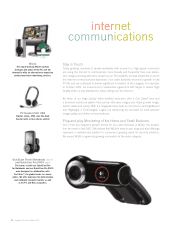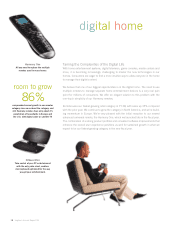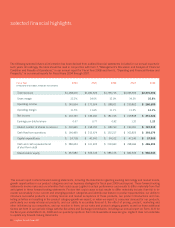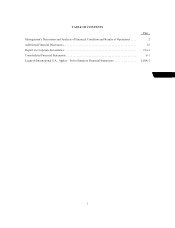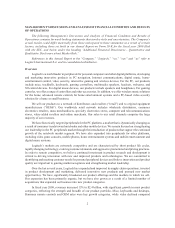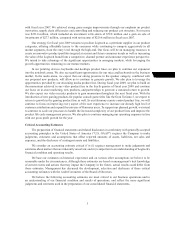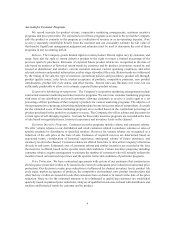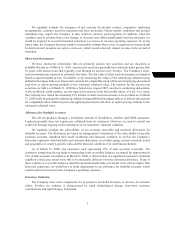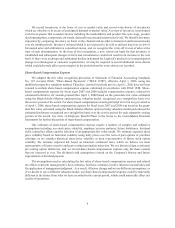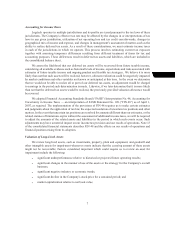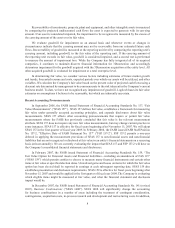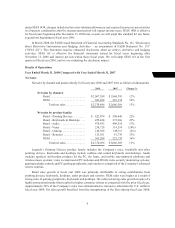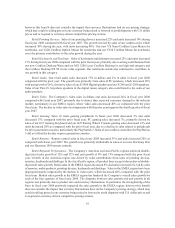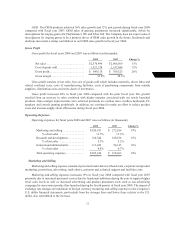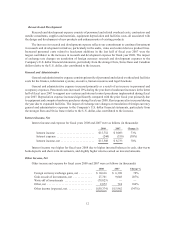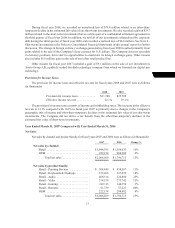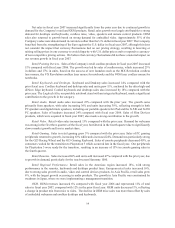Logitech 2008 Annual Report Download - page 26
Download and view the complete annual report
Please find page 26 of the 2008 Logitech annual report below. You can navigate through the pages in the report by either clicking on the pages listed below, or by using the keyword search tool below to find specific information within the annual report.4
Accruals for Customer Programs
We record accruals for product returns, cooperative marketing arrangements, customer incentive
programs and price protection. The estimated cost of these programs is accrued in the period the Company
sells the product or commits to the program as a reduction of revenue or as an operating expense, if we
receive a separately identifiable benefit from the customer and can reasonably estimate the fair value of
that benefit. Significant management judgment and estimates must be used to determine the cost of these
programs in any accounting period.
Returns. The Company grants limited rights to return product. Return rights vary by customer, and
range from just the right to return defective product to the right to return a limited percentage of the
previous quarter’s purchases. Estimates of expected future product returns are recognized at the time of
sale based on analyses of historical return trends by customer and by product, inventories owned by and
located at distributors and retailers, current customer demand, current operating conditions, and other
relevant customer and product information, such as stage of product life-cycle. Return trends are influenced
by the timing of the sale, the type of customer, operational policies and procedures, product sell-through,
product quality issues, sales levels, market acceptance of products, competitive pressures, new product
introductions, product life cycle status, and other factors. Return rates can fluctuate over time, but are
sufficiently predictable to allow us to estimate expected future product returns.
Cooperative Marketing Arrangements. The Company’s cooperative marketing arrangements include
contractual customer marketing and sales incentive programs. We enter into customer marketing programs
with most of our distribution and retail customers allowing customers to receive a credit equal to a set
percentage of their purchases of the Company’s products for various marketing programs. The objective of
these programs is to encourage advertising and promotional events to increase sales of our products. Accruals
for the estimated costs of these marketing programs are recorded based on the contractual percentage of
product purchased in the period we recognize revenue. The Company also offers rebates and discounts for
certain types of sell-through programs. Accruals for these sales incentive programs are recorded at the time
of sale based on negotiated terms, historical experience and inventory levels in the channel.
Customer Incentive Programs. Customer incentive programs include volume and consumer rebates.
We offer volume rebates to our distribution and retail customers related to purchase volumes or sales of
specific products by distributors to specified retailers. Reserves for volume rebates are recognized as a
reduction of the sale price at the time of sale. Estimates of required reserves are determined based on
negotiated terms, consideration of historical experience, anticipated volume of future purchases, and
inventory levels in the channel. Consumer rebates are offered from time to time at the Company’s discretion
directly to end-users. Estimated costs of consumer rebates and similar incentives are recorded at the time
the incentive is offered, based on the specific terms and conditions. Certain incentive programs, including
consumer rebates, require management to estimate the number of customers who will actually redeem the
incentive based on historical experience and the specific terms and conditions of particular programs.
Price Protection. We have contractual agreements with certain of our customers that contain terms
allowing price protection credits to be issued in the event of a subsequent price reduction (contractual price
protection). Our decision to make price reductions is influenced by channel inventory levels, product life
cycle stage, market acceptance of products, the competitive environment, new product introductions and
other factors. Credits are issued for units that customers have on hand or in transit at the date of the price
reduction. Reserves for the estimated amounts to be reimbursed to qualifying customers are established
quarterly based on planned price reductions, analyses of qualified inventories on hand with distributors and
retailers and historical trends by customer and by product.


